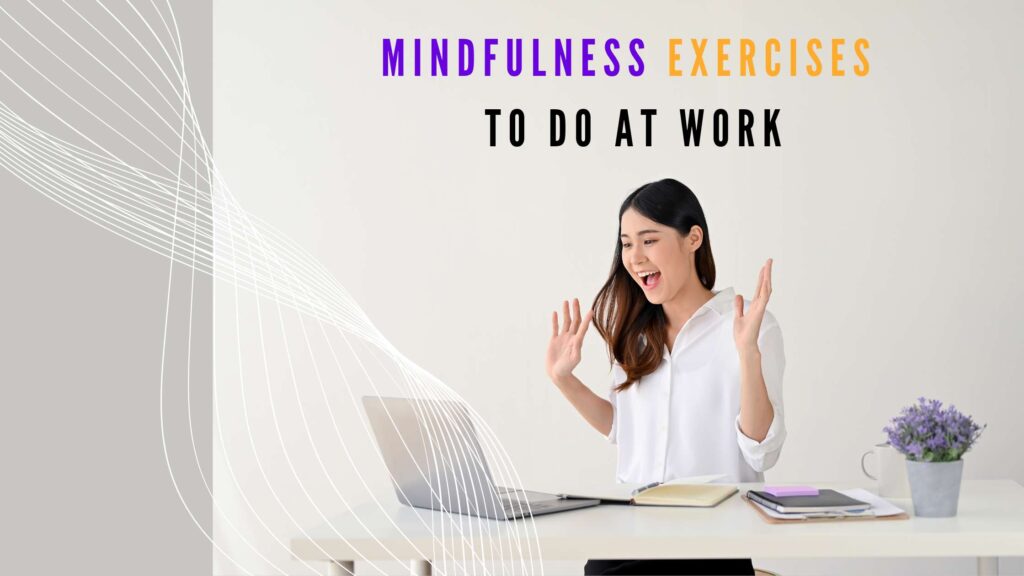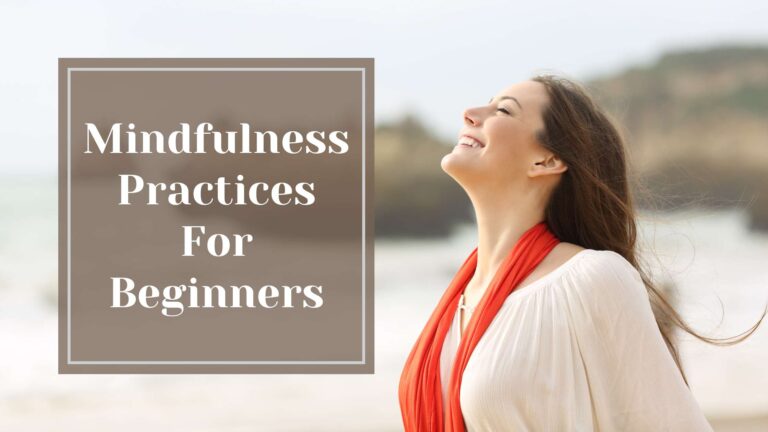What if just a few minutes of your day could help you feel calmer, more focused, and less overwhelmed? Mindfulness practices for beginners provide a simple yet powerful way to bring more awareness and peace into daily life. Whether you’re looking to reduce stress, improve concentration, or simply be more present, mindfulness can make a big difference, even if you’ve never tried it before.
In this post, you’ll learn five practical mindfulness techniques that are easy to incorporate into your routine. From mindful breathing to walking meditation, I will cover step-by-step exercises to help you start your journey. By the end, you’ll have the tools to build a mindfulness habit that fits into your life, no complicated techniques or prior experience required.
1. Simple Mindful Breathing Exercise
One of the easiest ways to start mindfulness is through your breath. Breathing happens naturally, but most people don’t pay attention to it. A mindful breathing exercise helps bring awareness to the present moment and calms the mind.
Why the Breath Is a Powerful Anchor for Mindfulness
Your breath is always with you. No matter where you are, you can use it to return to the present. When you focus on your breath, your mind has less room for stress and distractions. Studies show that slow, deep breathing can lower heart rate, reduce anxiety, and improve focus.
Step-by-Step Guide for Mindful Breathing
You don’t need a quiet room or special posture to practice mindful breathing. Here’s a simple exercise you can try:
- Find a comfortable position – Sit upright or lie down. Close your eyes if it feels comfortable.
- Take a deep breath in – Breathe in slowly through your nose. Notice how the air fills your lungs.
- Exhale gently – Breathe out through your mouth or nose. Feel the air leaving your body.
- Pay attention to each breath – Notice the rise and fall of your chest or the sensation of air passing through your nostrils.
- Refocus when your mind wanders – It’s normal for thoughts to arise. When they do, gently bring your attention back to your breath.
Start with just one or two minutes and slowly increase the time as you feel comfortable.
2. Body Scan Meditation
The body holds tension, often without us noticing. A body scan meditation helps you reconnect with your body and release built-up stress. This practice brings awareness to different areas of the body, promoting relaxation and mindfulness.
What is a Body Scan Meditation?
A body scan is a simple way to check in with yourself. It involves paying attention to different parts of your body, from head to toe. Instead of trying to change anything, you simply notice sensations, tightness, warmth, tingling, or even numbness. This practice helps you become more aware of how your body feels in the present moment.
Step-by-Step Guide to Practicing a Body Scan
You can do a body scan while lying down or sitting in a comfortable position. Here’s how:
- Find a quiet place – Sit or lie down in a position where you feel relaxed but alert. Close your eyes if it feels comfortable.
- Take a few deep breaths – Inhale slowly through your nose, exhale gently through your mouth. Let go of any tension.
- Start with your head – Bring your attention to your forehead. Notice if there’s any tightness. Relax your facial muscles.
- Move down through your body – Shift your focus to your neck, shoulders, arms, hands, chest, belly, and so on. Spend a few moments on each area.
- Notice sensations without judgment – If you feel tension, acknowledge it. Don’t try to force it away. Just observe.
- Reach your feet – Finally, bring awareness to your legs, ankles, and feet. Feel the connection between your body and the surface beneath you.
- Take a final deep breath – Slowly bring your attention back to the room. Open your eyes when you’re ready.
A full body scan can take 5 to 15 minutes, but even a short version is helpful.

Have you tried any of these mindfulness exercises at work?
Start with just one exercise today and notice the difference!
Make mindfulness a regular part of your workday and experience the positive impact on focus, and productivity.
Which exercise will you try first?
3. Mindful Walking
Mindfulness doesn’t have to be practiced while sitting still. Walking can also be a form of meditation. Mindful walking helps you stay present, clear your mind, and connect with your surroundings.
Why Walking Can Be a Mindfulness Practice
Most people walk while thinking about something else; plans, worries, or distractions. Mindful walking shifts your focus to the act of walking itself. It turns an everyday movement into a calming and grounding experience.
Step-by-Step Guide to Mindful Walking
You don’t need a special place for this practice. You can do it indoors or outdoors, wherever you have space to walk. Here’s how:
- Stand still for a moment – Before you start walking, take a deep breath. Feel your feet touching the ground.
- Walk slowly and naturally – Begin walking at a comfortable pace. Let your arms and body move freely.
- Focus on each step – Notice how your foot lifts, moves forward, and touches the ground again.
- Pay attention to sensations – Feel the texture of the floor or ground beneath you. Sense the movement in your legs and body.
- Be aware of your surroundings – Observe the sights, sounds, and smells around you without judgment.
- Refocus when your mind wanders – If thoughts arise, gently bring your attention back to your steps.
- Walk for a few minutes – Start with 5–10 minutes. Over time, you can extend your practice.
4. Eating Mindfully
Many people eat in a rush, distracted by screens or thoughts. Mindful eating helps you slow down, enjoy your food, and listen to your body’s signals. It turns eating into a peaceful and satisfying experience.
The Importance of Eating with Awareness
Eating mindfully isn’t about following a diet. It’s about being fully present with your food. When you eat with awareness, you notice flavors, textures, and smells. This can help you enjoy meals more and prevent overeating.
How to Practice Mindful Eating
You can try this practice with any meal or snack. Here’s how:
- Pause before eating – Take a deep breath. Look at your food. Notice its colors, shapes, and textures.
- Eat slowly – Take small bites and chew carefully. Pay attention to the taste and feel of the food in your mouth.
- Avoid distractions – Turn off the TV and put away your phone. Focus only on eating.
- Notice hunger and fullness – Pay attention to how your body feels. Stop eating when you feel satisfied, not overly full.
- Appreciate your food – Think about where it came from and the effort it took to prepare it.

Have you tried any of these mindfulness techniques at work?
Start with one technique and commit to practicing it daily.
Apply these simple mindfulness techniques to reduce stress, improve focus, and better well-being!
5. Managing Thoughts & Emotions with Mindfulness
The mind is always active, jumping from one thought to another. Some thoughts bring peace, while others create stress. Mindfulness helps you observe your thoughts and emotions without being controlled by them.
You Don’t Have to Control Your Thoughts
Many beginners think mindfulness means stopping thoughts. But thoughts are natural. Instead of fighting them, mindfulness teaches you to notice them without getting stuck. Imagine your thoughts as clouds in the sky, just watch them pass without holding on.
The Practice of Labeling Thoughts
A simple way to manage thoughts is by labeling them. When a thought arises, mentally note what it is:
- Thinking – When your mind drifts into planning or remembering.
- Worrying – When you feel anxious about the future.
- Judging – When you criticize yourself or others.
Labeling helps you step back and see thoughts for what they are, just thoughts, not facts.
How to Observe Emotions Without Feeling Overwhelmed
Emotions can be strong, but mindfulness helps you handle them with care. Here’s a simple way to practice:
- Pause and take a deep breath – When a strong emotion arises, don’t react immediately.
- Name the emotion – Say to yourself, “This is anger” or “This is sadness.”
- Feel it in your body – Notice where you feel the emotion (tight chest, tense jaw, heavy stomach).
- Allow it to be there – Don’t push it away. Just observe it without judgment.
- Let it pass naturally – Like waves in the ocean, emotions rise and fall. Trust that they won’t last forever.
Final Thoughts
Mindfulness is not about perfection. It is about practice. Simple habits like mindful breathing, body scans, and mindful eating can bring more awareness and calm into your daily life. By paying attention to your thoughts and emotions without judgment, you can respond to challenges with greater clarity and ease.
The key is to start small. Choose one mindfulness practice and try it for a few minutes each day. Over time, these small moments of awareness will add up, helping you feel more present, focused, and at peace. Mindfulness is a journey, and every step you take brings you closer to a calmer, more mindful life.

Start Your Mindfulness Practice Today
Mindfulness can be as simple as paying attention to the moment you’re in. Why not begin today?
Whether you’re breathing, eating, or even driving, bring a bit of mindfulness into your day and experience the difference!

